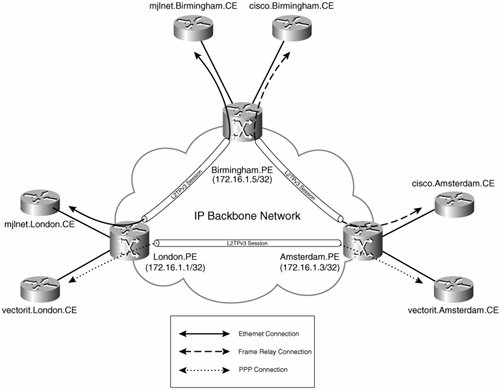Designing and Deploying L2TPv3-Based Layer 2 VPNs
Layer 2 VPNs (L2VPN) can be used to provide site-to-site Layer 2 connectivity. As discussed in Chapter 1, "What Is a Virtual Private Network?" L2VPNs can be built using technologies and protocols such as the Layer Two Tunneling Protocol version 3 (L2TPv3, RFC3931) and Any Transport over MPLS (AToM) and can fall into three categories:
- Virtual Private Wire Service (VPWS) This type of L2VPN provides point-to-point MAN or WAN transport for Layer 2 protocols and connections such as Ethernet, High-Level Data Link Control (HDLC), PPP, Frame Relay, and ATM.
- Virtual Private LAN Service (VPLS) A VPLS provides multipoint Ethernet connectivity.
- IP-only Private LAN Service (IPLS) This is a newer type of L2VPN, and it provides multipoint IP-only connectivity.
A common question asked about L2VPNs (including L2TPv3-based L2VPNs) is why they might be preferred over Layer 3 site-to-site VPNs and when their deployment might be suitable.
L2TPv3 pseudowire (emulated circuit)-based L2VPNs are typically deployed by service providers in order to consolidate legacy and newer IP network infrastructure and offer newer Ethernet-based WAN connectivity to their customers. Figure 2-1 illustrates an L2TPv3-based L2VPN. Figure 2-1 shows L2TPv3 sessions over an IP backbone network between service Provider Edge (PE) routers: London.PE, Birmingham.PE, and Amsterdam.PE. The L2TPv3 sessions in Figure 2-1 are transporting the following Layer 2 protocol connections:
- An Ethernet connection between Customer Edge (CE) routers mjlnet.London.PE and mjlnet.Birmingham.CE
- A Frame Relay connection between CE routers cisco.Birmingham.CE and cisco.Amsterdam.CE
- A PPP connection between CE routers vectorit.London.CE and vectorit.Amsterdam.CE
Figure 2-1. L2TPv3-Based L2VPN

Part I: Understanding VPN Technology
What Is a Virtual Private Network?
- What Is a Virtual Private Network?
- VPN Devices
- Deploying Site-to-Site and Remote Access VPNs: A Comparison
- Summary
- Review Questions
Part II: Site-to-Site VPNs
Designing and Deploying L2TPv3-Based Layer 2 VPNs
- Designing and Deploying L2TPv3-Based Layer 2 VPNs
- Benefits and Drawbacks of L2TPv3-Based L2VPNs
- L2TPv3 Pseudowire Operation
- Configuring and Verifying L2TPv3 Pseudowires
- Summary
- Review Questions
Designing and Implementing AToM-Based Layer 2 VPNs
- Designing and Implementing AToM-Based Layer 2 VPNs
- Benefits and Drawbacks of AToM-Based L2VPNs
- AToM Pseudowire Operation
- Deploying AToM Pseudowires
- Implementing Advanced AToM Features
- Summary
- Review Questions
Designing MPLS Layer 3 Site-to-Site VPNs
- Designing MPLS Layer 3 Site-to-Site VPNs
- Advantages and Disadvantages of MPLS Layer 3 VPNs
- MPLS Layer 3 VPNs Overview
- A Detailed Examination of MPLS Layer 3 VPNs
- Deploying MPLS Layer 3 VPNs
- Summary
- Review Questions
Advanced MPLS Layer 3 VPN Deployment Considerations
- Advanced MPLS Layer 3 VPN Deployment Considerations
- The Carriers Carrier Architecture
- The Inter-Autonomous System/Interprovider MPLS VPN Architecture
- Supporting Multicast Transport in MPLS Layer 3 VPNs
- Implementing QoS for MPLS Layer 3 VPNs
- Supporting IPv6 Traffic Transport in MPLS Layer 3 VPNs Using 6VPE
- Summary
- Review Questions
Deploying Site-to-Site IPsec VPNs
- Deploying Site-to-Site IPsec VPNs
- Advantages and Disadvantages of IPsec Site-to-Site VPNs
- IPsec: A Security Architecture for IP
- Deploying IPsec VPNs: Fundamental Considerations
- Summary
- Review Questions
Scaling and Optimizing IPsec VPNs
- Scaling and Optimizing IPsec VPNs
- Scaling IPsec Virtual Private Networks
- Ensuring High Availability in an IPsec VPN
- Designing QoS for IPsec VPNs
- MTU and Fragmentation Considerations in an IPsec VPN
- Summary
- Review Questions
Part III: Remote Access VPNs
Designing and Implementing L2TPv2 and L2TPv3 Remote Access VPNs
- Designing and Implementing L2TPv2 and L2TPv3 Remote Access VPNs
- Benefits and Drawbacks of L2TP Remote Access VPNs
- Operation of L2TP Voluntary/Client-Initiated Tunnel Mode
- Implementing L2TP Voluntary/Client-Initiated Tunnel Mode Remote Access VPNs
- Designing and Implementing L2TP Compulsory/NAS-Initiated Tunnel Mode Remote Access VPNs
- Integrating L2TP Remote Access VPNs with MPLS VPNs
- Summary
- Review Questions
Designing and Deploying IPsec Remote Access and Teleworker VPNs
- Designing and Deploying IPsec Remote Access and Teleworker VPNs
- Comparing IPsec Remote Access VPNs with Other Types of Remote Access VPNs
- Understanding IKE in an IPsec Remote Access VPN Environment
- Deploying IPsec Remote Access VPNs Using Preshared Key and Digital Signature Authentication
- Summary
- Review Questions
Designing and Building SSL Remote Access VPNs (WebVPN)
- Designing and Building SSL Remote Access VPNs (WebVPN)
- Comparing SSL VPNs to Other Types of Remote Access VPNs
- Understanding the Operation of SSL Remote Access VPNs
- Using Clientless SSL Remote Access VPNs (WebVPN) on the Cisco VPN 3000 Concentrator
- Implementing Full Network Access Using the Cisco SSL VPN Client
- Strengthening SSL Remote Access VPNs Security by Implementing Cisco Secure Desktop
- Enabling SSL VPNs (WebVPN) on Cisco IOS Devices
- Deploying SSL VPNs (WebVPN) on the ASA 5500
- Summary
- Review Questions
Part IV: Appendixes
Designing and Building SSL Remote Access VPNs (WebVPN)
- Designing and Building SSL Remote Access VPNs (WebVPN)
- Appendix A. VPLS and IPLS Layer 2 VPNs
- Understanding VPLS
- Understanding IPLS
- Summary: Comparing VPLS and IPLS
Appendix B. Answers to Review Questions
EAN: 2147483647
Pages: 124
- Article 240 Overcurrent Protection
- Article 424: Fixed Electric Space Heating Equipment
- Article 427: Fixed Electric Heating Equipment for Pipelines and Vessels
- Article 645 Information Technology Equipment
- Example No. D2(b) Optional Calculation for One-Family Dwelling, Air Conditioning Larger than Heating [See 220.82(A) and 220.82(C)]
